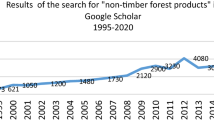Abstract
The current interest in non-timber forest products as an economic option for the Brazilian Amazon represents a radical departure from the policies that have guided development in the region during recent decades. Despite this interest, little is currently known about the forms of resource management or economic strategies practiced by populations dependent on such resources. In this study, we measured the annual income and expenditures of ten households on Combu Island, located in the Amazon estuary near the major port city of Belém; in addition, we documented local uses and management of natural resources on the island Average annual income per household was found to be over U.S. $4000, derived primarily from the harvest and sale of non-timber forest products. The results of this study show that the combination of proximity to a major market and appropriate resource management can lead to high and apparently sustainable economic returns.
Similar content being viewed by others
References
Alcorn, J. B. (1984).Huastec Mayan Ethnobotany. University of Texas Press, Austin.
Anderson, A. B. (1990). Extraction and forest management by rural inhabitants in the Amazon estuary. In Anderson, A. B. (ed.),Alternatives to Deforestation: Steps Toward Sustainable Use of the Amazon Rain Forest. Columbia University Press, New York, pp. 65–85.
Anderson, A. B., and Ioris, E. M. (1992). The logic of extraction: Resource management and income generation by extractive producers in the Amazon estuary. In Redford, K. H. and Padoch, C. (eds.),Conservation of Neotropical Forests: Working from Traditional Resource Use. Columbia University Press, New York, pp. 175–199.
Anderson, A. B., and Jardim, M. A. G. (1989). Costs and benefits of flood plain forest management by rural inhabitants in the Amazon estuary: A case study of açaí palm production. In Browder, J. O. (ed.),Fragile Lands of Latin America: Strategies for Sustainable Development. Westview Press, Boulder, Colorado, pp. 114–129.
Anderson, A. B., Gely, A., Strudwick, J., Sobel, G. L., and Pinto, M. G. C. (1985). Um sistema agroflorestal no estuário amazônico (Ilha das Onças, Município de Barcarena, Estado do Pará).Acta Amazônica 15(1–2):(Suppl.) 195–224.
Browder, J. O. (1992). The limits of extractivism: Tropical forest strategies beyond extractive reserves.Bioscience 42(3): 174–182.
Denevan, W. M., and Padoch, C. (1988).Swidden-Fallow Agroforestry in the Peruvian Amazon. Advances in Economic Botany 5.
Flohrschultz, G. H. H. (1983). Análise Econômica de Estabelecimentos Rurais do Município de Tomé -Acu, Pará: Um Estudo de Caso. EMBRAPA/CPATU Documentos 19, Belém, Brazil.
Guerra, A. T. (1977).Geografia do Brasil—Grande Região Norte (Vol. 1). Fundação Instituto Brasileiro de Geografia e Estatística, Rio de Janeiro.
Hecht, S. B., Anderson, A. B., and May, P. H. (1988). The subsidy from nature: Shifting cultivation, successional palm forests, and rural development.Human Organization 47(1): 25–35.
Hiraoka, M. (1985). Flood plain farming in the Peruvian Amazon.Geographical Review of Japan 58 (Ser.B)(1): 1–23.
Homma, A. K. O. (1989). Reservas extrativistas: Uma opção de desenvolvimento viável para a Amazônia?Pará Desenvolvimento 25: 38–48.
IBGE (1978).Produção Extrativa Vegetal 1976. Fundação Instituto Brasileiro de Geografia e Estatística, Rio de Janeiro, Brazil.
IBGE (1981).Produção Extrativa Vegetal 1978. Fundação Instituto Brasileiro de Geografia e Estatística, Rio de Janeiro, Brazil.
IBGE (1982).Censo Demográfico 1980. Fundaço Instituto Brasileiro de Geografia e Estatística, Rio de Janeiro, Brazil.
IBGE (1984).Produção Extrativa Vegetal 1982. Fundação Instituto Brasileiro de Geografia e Estatística, Rio de Janeiro, Brazil.
IBGE (1988).Produção Extraço Vegetal e da Silvicultura 1986. Fundação Instituto Brasileiro de Geografia e Estatística, Rio de Janeiro, Brazil.
Lima, R. (1956).A Agricultura na Várzea do Estuário do Amazonas. Boletim Técnico do Instituto Agronômico do Norte, Belém.
Magee, P. L. (1990). The Water Is Our Land: Peasants of the River Tocantins, Brazilian Amazonia. Doctoral dissertation, University of Florida, Gainesville, Florida.
Padoch, C., Chota Inuma, J., De Jong, W., and Unruh, J. (1985). Amazonian agroforestry: A market-oriented system in Peru.Agroforestry Systems 3: 47–58.
Parker, E. P. (1985).The Amazon Caboclo: Historical and Comtemporary Perspectives. Studies in Third World Societies 32, Williamsburg, Virginia.
Peters, C., Gentry, A. H., and Mendelsohn, R. O. (1989). Valuation of an Amazonian rainforest.Nature 339: 655–656.
Schwartzman, S. (1989). Extractive reserves: The rubber tappers' strategy for sustainable use of the Amazon rainforest. In Browder, J. O. (ed.),Fragile Lands of Latin America: Strategies for Sustainable Development. Westview Press, Boulder, Colorado, pp. 150–165.
Smith, N. J. H. (1981).Man, Fishes, and the Amazon. Columbia University Press, New York.
Vieira, L. C., Carvalho e Oliveira, N. V., and Bastos, T. X. (1971).Os Solos do Estado do Pará. Cadernos Paraenses do IDESP, Belém, Brazil.
Author information
Authors and Affiliations
Additional information
Formerly Senior Researcher at the Museu Paraense Emílio Goeldi
Formerly Student Fellow at the Museu Paraense Emílio Goeldi
Rights and permissions
About this article
Cite this article
Anderson, A.B., Ioris, E.M. Valuing the rain forest: Economic strategies by small-scale forest extractivists in the Amazon estuary. Hum Ecol 20, 337–369 (1992). https://doi.org/10.1007/BF00889901
Issue Date:
DOI: https://doi.org/10.1007/BF00889901




